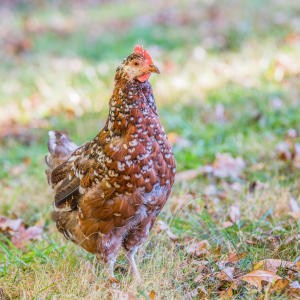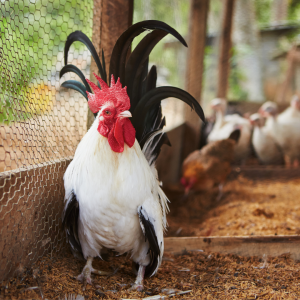Let’s talk chicken…I know you know what I am talking about. We all have those rough days where we just walk out to the coop and look at that one chicken and just let it out. We spill the beans and tell them how life got to us and sometimes it can be therapeutic and relaxing and even liberating to get it off your chest. Have you ever thought about what they may be saying while you’re just, yah know, spilling your beans.
Chickens communicate in so many different ways from a fluff of a feather, kicking grass or dirt, a twitch in the head, and even a noise that to us sounds like something a dinosaur would make. I have owned chickens now for 5+ years and watching them and being around them has been some of the most relaxing moments in my life.

If you are home every day at the same time or not, I challenge you to grab a snack for you AND THEM. Don’t be rude and eat in-front of them without sharing something. I am not kidding, you will surely lose your snack and some of their respect. Those little 2 leggers have an appetite like a piggy and we are their suppliers. So, back to my challenge – grab snacks and for an entire week RAIN OR SHINE, sit with them and feed them, watch them, and talk to them. You will learn all these things I am going to tell you and it will make things more fun for everyone and let’s be honest we know you have chicken friends who will love to hear this and think “you’re their go to chicken friend because you know so many random things that are just kind of cool!”
Many people that have purchased baby chicks this year even if the bin said pullet, received a rooster. If you didn’t, tell me where you shopped, because this chicken mom got 9 out of the 30 pullets I purchased. I am a sucker too for wanting to keep them because I think they are strong and they communicate the most with us. If you have baby roosters don’t shun them or cast them aside, hold them and spoil them. Most likely by 2 years old their hormones develop differently and they become a smidgen more territorial. Do not worry, this is all fixable and I’ll share that with you too.
While you do your challenge you will see your roosters dance. Watch their feet, they move quick and they go back and forth and side to side. This is to help them find larger pieces of food and kick it back to their hens. It is also a way to always be on guard and move quickly if a predator is near. If your rooster is too close, never swat at them! Just click with your tongue louder and louder and walk in their direction. This is an actual form of communicating with them to tell them, I won’t hurt your ladies and please move. Stand your ground and sit where you want. If your rooster spurs you simply pick them up and hold them with your snack. I use cracked corn for my birds. I place a bucket between my legs and hold my rooster. Let him see he is welcome to the bucket while you hold him. It may take a few minutes to calm down and realize this. This helps them realize you are here to enjoy their company. After doing this for a week, all the birds will KINDLY come running like baby velociraptors toward you.
Roosters also show their crow by standing tall and extending the neck, allowing them to increase their vocal cords vibrations and make for a louder crow. The first crow is to signify that it is morning and to tell his hens to gather near for foraging will begin soon. Another crow that is loud but not as high pitch is to demand territory. This is to tell predators in the sky that they live here and to back off. Or your rooster may feel threatened by you and vocalize this to you.

When a hen is popping her eggs out she will cluck loud to warn the flock that she is laying an egg, this is also to let other hens know so that the younger hens are welcome to lay there as well. Multiple hens lay in the same box to ensure their egg is safer and to allow themselves to be safer during the process from any predators. Being new layers is a big deal so learning from the older hens is a healthy process for your flock.
Chicken ears are located on the side of the head, looking almost like a hole. When talking to your chickens they will turn an ear toward you to show they hear you. Don’t think they are ignoring you moving on, they will stretch their necks up and turn their heads and listen to you. During snack time or free ranging time you will notice a twitch in their heads after they have had their fill of food. This is nothing to be alarmed of. They are simply doing it to clear their crop and allow food to pass through. It can also be something done if they hear an insect coming. A chickens hearing is much better than ours, they can hear 10x stronger than we can. So an insect’s vibrations from wings are much louder. But be aware this sensory can easily be tuned out when they are asleep. Sleeping for them is more of a meditation time to heal and rest. So they detach themselves from the world and get lost in their dreams. Have you have heard your hens cluck/ chicken bark when they are laying eggs? Well add a grumble and screech and you have yourself a broody hen.
Doing a snack time and being around your chickens will help bring your broody hens out for some food. But for those who are first time chicken owners, a broody hen will show so many signs that she is ready to be a mom and wants her space. While she eats, she will fluff her neck and side feathers out. Think of the tiny dinosaur on Jurassic Park that attacked the man with the glasses when his vehicle broke down – his gills shot out around his head like an umbrella. Well, hens do that with feathers around their neck to tell you “these eggs are mine to protect and hatch or please give me space, no touchy.” Depending on whether she is in her nest box or on the ground, those would be a round-about idea of what you will see and hear. The grumble and screech is also to warn the rooster that something is coming for her eggs and to come help!
Hens will also squeak and lightly cluck near close friends, the hens that they enjoy their company by. It will be an honor when they do it for you during your routine snack time with them.
Look at all your chickens closely at these times. You will see so much communication between them and you. You will be so surprised by who wants to trust you so much that they come feathers length from you. Roosters will surprise you by being so interactive with you and their flock.
Always keep an eye out for chickens secluding themselves from the flock, see who is molting ok and who is not, look at eyes and ears as they pass by. You will learn so much about each breed by doing this and making sure your flock is safe and healthy.
We have 30+ hens and 9 roosters and I have been doing this challenge for 2 weeks, my roosters are by far my most interactive in the flock. They will sit on my lap, sit near me, come up to me and just eat as close as they can to me. I hope this challenge brings some peace into your life and builds some love and trust with your flock. I only do it for about 10 to 30 minutes depending on if the turkeys and ducks join the snack time. I have been building as much bonding time with my turkeys due to my fear of turkeys. So it has been so wonderful for me doing this.
SO! THE CHALLENGE BEGINS GET YOUR BUTT OUTSIDE! AND TELL ME WHAT YOU LEARN
ALSO!!! If you have not already read my blog on starting a garden for the chickens, I recommend it because this can come in handy once it’s time to harvest these veggies and fruits. They can be the snack you provide your feathered friends. I hope you enjoyed todays blog and you accept my challenge. If you have children or grand-children, I encourage you to bring them in on the challenge. Your chickens would love to meet them on a ground level and see just how amazing they are!
Talk soon everyone! Big Hugs!
Amanda B.